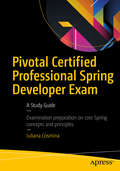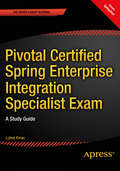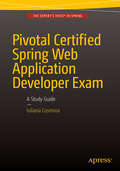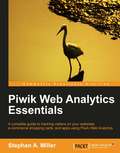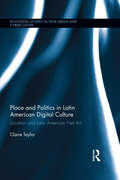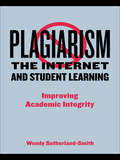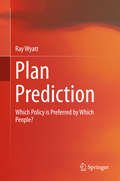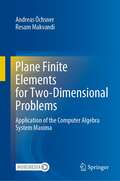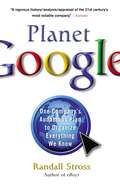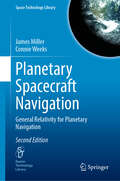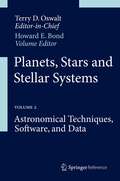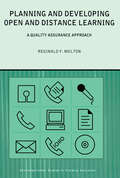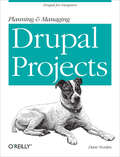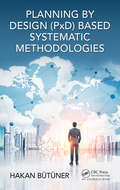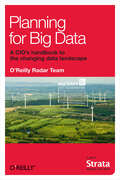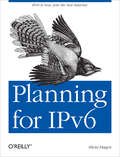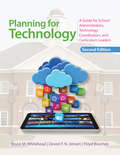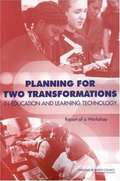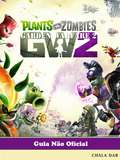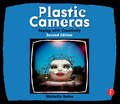- Table View
- List View
Pivotal Certified Professional Spring Developer Exam
by Iuliana CosminaPass the Pivotal Certified Professional exam using source code examples, study summaries, and mock exams. In this book, you'll find a descriptive overview of certification-related Spring modules and a single example application demonstrating the use of all required Spring modules. Also, it is suitable as an introductory primer for Spring newcomers.Furthermore, in Pivotal Certified Professional Spring Developer Exam: A Study Guide each chapter contains a brief study summary and question set, and the book’s free downloadable source code package includes one mock exam (50 questions – like a real exam). After using this study guide, you will be ready to take and pass the Pivotal Certified Professional exam.When you become Pivotal Certified, you will have one of the most valuable credentials in Java. The demand for Spring skills is skyrocketing. Pivotal certification helps you advance your skills and your career, and get the maximum benefit from Spring. Passing the exam demonstrates your understanding of Spring and validates your familiarity with: container-basics, aspect oriented programming (AOP), data access and transactions, Spring Security, Spring Boot, microservices and the Spring model-view-controller (MVC). Good luck!What You'll LearnUnderstand the core principles of the popular Spring FrameworkUse dependency injectionWork with aspects in Spring and do AOP (aspect oriented programming)Control transactional behavior and work with SQL and NoSQL (MongoDB) databasesCreate and secure web applications based on Spring MVCGet to know the format of exam and type of questions in itCreate Spring microservices applicationsWho This Book Is ForSpring developers who have taken the Pivotal Core Spring class are eligible to take the Pivotal Certified Professional exam.
Pivotal Certified Spring Enterprise Integration Specialist Exam
by Lubos KrnacExam topics covered include tasks and scheduling, remoting, the Spring Web Services framework, RESTful services with Spring MVC, the Spring JMS module, JMS and JTA transactions with Spring, batch processing with Spring Batch and the Spring Integration framework. Prepare with confidence for the Pivotal Enterprise Integration with Spring Exam. One of the important aspects of this book is a focus on new and modern abstractions provided by Spring. Therefore most of the features are shown with Java annotations alongside established XML configurations. Most of the examples in the book are also based on the Spring Boot framework. Spring Boot adoption is exponential because of its capability to significantly simplify Spring configuration using sensible opinionated defaults. But Spring Boot is not the target of the exam, therefore all the features are also covered with plain Spring configuration examples. What you'll learn How to use Spring to create concurrent applications and schedule tasks How to do remoting to implement client-server applications How to work with Spring Web services to create loosely coupled Web services and clients How to use Spring MVC to create RESTful web services and clients How to integrate JMS for asynchronous messaging-based communication How to use local JMS transactions with Spring How to configure global JTA transactions with Spring How to use Spring Integration to create event-driven pipes-and-filters architectures and integrate with external applications How to use Spring Batch for managed, scalable batch processing that is based on both custom and built-in processing components Who this book is for This book is for developers and architects with experience in programming and developing with the Spring Framework. Prerequisites are an understanding of Java, the dependency injection pattern and the Spring Inversion of Control container. All other features needed for the exam are covered from scratch, and are presented so as to be understandable to beginners as well as valuable for intermediates or experts. Table of Contents 1. Tasks and Scheduling 2. Spring Remoting 3. Spring Web Services 4. RESTful Services with Spring MVC 5. Spring JMS 6. JMS Transactions 7. Distributed Transactions 8. Spring Integration 9. Spring Batch
Pivotal Certified Spring Web Application Developer Exam
by Iuliana CosminaPrepare for the Pivotal Certified Spring Web Application Developer exam and learn about Spring MVC DispatcherServlet configuration, Spring MVC programming model essentials, Spring MVC views and form processing, Spring Web Flow essentials, and Spring Web Flow actions and configuration. The Pivotal Certified Spring Web Application Developer Exam: A Study Guide is the ideal preparation for the exam and after reading and using it, you'll be able to pass and become a certified Spring Web Developer. When you become a Pivotal Certified Spring Web Application Developer, you'll receive one of the most valuable credentials available in enterprise Java. Achieving this certification demonstrates your ability to apply Spring's web projects to develop real-world Java web applications and validates your familiarity with Spring Web. What you'll learn How to use the Spring Framework to develop Web applications How to use Spring Web Flow to implement stateful interactions How to secure Web applications with Spring Security How to test Web applications for correctness and performance How to create rich Web user interfaces with Ajax and JQuery How to use Spring Boot to create a Spring Web application in minutes Who this book is for Architects and developers who have experience using Java to develop applications and a basic understanding of Spring who are looking to gain the benefits of this certification credential. Table of Contents 1. Introduction 2. Spring Fundamentals 3. Spring MVC 4. Spring Portlets 5. Spring RESTful Services 6. Spring Web with Ajax 7. Spring Web Flow 8. Spring Web Socket 9. Appendix A: Exercise Answers
Piwik Web Analytics Essentials
by Stephan MillerPacked with code and the necessary screenshots, this is a step-by-step comprehensive tutorial which will help you learn about Piwik quickly and easily,This book is for everyone ranging from a reader who is new to web analytics to a seasoned coding expert wanting to switch to Piwik from another analytics tool. If you are a newbie, you will learn to install Piwik, install tracking, and customize the JavaScript for their custom needs, as well as why they need to track their visitors. If you are an advanced reader, you will learn to mix JavaScript with PHP, Flash, and other languages in order to write plugins for custom software.
Place and Politics in Latin American Digital Culture: Location and Latin American Net Art (Routledge Studies in New Media and Cyberculture #20)
by Claire TaylorThis volume explores one of the central issues that has been debated in internet studies in recent years: locality, and the extent to which cultural production online can be embedded in a specific place. The particular focus of the book is on the practices of net artists in Latin America, and how their work interrogates some of the central place-based concerns of Latin(o) American identity through their on- and offline cultural practice. Six particular works by artists of different countries in Latin America and within Latina/o communities in the US are studied in detail, with one each from Uruguay, Chile, Argentina, Colombia, the US-Mexico border, and the US. Each chapter explores how each artist represents place in their works, and, in particular how traditional place-based affiliations, or notions of territorial identity, end up reproduced, re-affirmed, or even transformed online. At the same time, the book explores how these net.artists make use of new media technologies to express alternative viewpoints about the locations they represent, and use the internet as a space for the recuperation of cultural memory.
Plagiarism, the Internet, and Student Learning: Improving Academic Integrity
by Wendy Sutherland-SmithWritten for Higher Education educators, managers and policy-makers, Plagiarism, the Internet and Student Learning combines theoretical understandings with a practical model of plagiarism and aims to explain why and how plagiarism developed. It offers a new way to conceptualize plagiarism and provides a framework for professionals dealing with plagiarism in higher education. Sutherland-Smith presents a model of plagiarism, called the plagiarism continuum, which usefully informs discussion and direction of plagiarism management in most educational settings. The model was developed from a cross-disciplinary examination of plagiarism with a particular focus on understanding how educators and students perceive and respond to issues of plagiarism. The evolution of plagiarism, from its birth in Law, to a global issue, poses challenges to international educators in diverse cultural settings. The case studies included are the voices of educators and students discussing the complexity of plagiarism in policy and practice, as well as the tensions between institutional and individual responses. A review of international studies plus qualitative empirical research on plagiarism, conducted in Australia between 2004-2006, explain why it has emerged as a major issue. The book examines current teaching approaches in light of issues surrounding plagiarism, particularly Internet plagiarism. The model affords insight into ways in which teaching and learning approaches can be enhanced to cope with the ever-changing face of plagiarism. This book challenges Higher Education educators, managers and policy-makers to examine their own beliefs and practices in managing the phenomenon of plagiarism in academic writing.
Plagues (The Darwin College Lectures)
by Sven Friedemann Jonathan L. HeeneyPlagues have inflicted misery and suffering throughout history. They can be traced through generations in our genes, with echoes in religion and literature. Featuring essays arising from the 2014 Darwin College Lectures, this book examines the spectrum of tragic consequences of different types of plagues, from infectious diseases to over-population and computer viruses. The essays analyse the impact that plagues have had on humanity and animals, and their threat to the very survival of the world as we know it. On the theme of plagues, each essay takes a unique perspective, ranging from the impact of plagues on history, medicine, the evolution of species, and biblical metaphors, to their impact on national economies, and even our highly connected digital lifestyles. This engaging and timely collection challenges our understanding of plagues, and asks if plagues are the manifestation of nature's checks and balances in light of human population growth and our impact on climate change. A stimulating collection of essays written by a distinguished group of scholars with a diverse approach to their theme. Provides a multidisciplinary examination of the effects of plagues, from early history to current medicine and the future. Analyses different types of plagues, from infectious diseases to over-population and computer viruses.
Plan Prediction
by Ray WyattThis book develops an innovative system, in the form of an "app", that harnesses the power of the internet to predict which sorts of people will prefer which policy in ANY planning situation. It chronicles the accumulated research wisdom behind the system's reasoning, along with several less successful approaches to policy making that have been found wanting in the past - including the myth, usually peddled by strategic planners, that it is possible to find a "best" plan which optimally satisfies everybody. The book lays out an entirely new kind of Planning Support System (PSS). It will facilitate decision-making that is far more community-sensitive than previously, and it will drastically improve the performance of anyone who needs to plan within socially-sensitive contexts - which is all of us. A standout feature of the system is its commitment to "scientific rigour", as shown by its predicted plan scores always being graphically presented within error margins so that true statistical significance is instantly observable. Moreover, the probabilities that its predictions are correct are always shown - a refreshing change from most, if not all other Decision Support Systems (DSS) that simply expect users to accept their outputs on faith alone.
Plan de Acción de Shopify: 6 Pasos para Construir un Negocio de Triangulación de Envíos
by Alessandro¿Estás Listo Para Convertirte En Un Experto De La Triangulación de Envíos En Solo 6 Sencillos Pasos? No tienes que pagar una pequeña fortuna por cursos en línea o pasar meses investigando. El Plan de Acción de Shopify: 6 Pasos para Construir un Negocio de Triangulación de Envíos está aquí para ahorrarte un tiempo valioso y un esfuerzo invaluable al ofrecerte la más esencial guía de Dropshipping, para que puedas construir tu propio imperio de triangulación de envíos! Incluso si no tienes absolutamente ninguna experiencia, ¡esta guía completa de Shopify te enseñará todo lo que necesitas saber! Al Final De Esta Guía Completa de Dropshipping Serás Capaz De: Entender El Proceso de Triangulación de Envíos Buscar Los Mejores Proveedores Identificar Cuáles Productos Se Venden Mejor Encontrar Tu Nicho Configurar Tu Tienda Shopify Establecer Precios y Páginas de Productos Anunciar y Promover Tu Nuevo Negocio ¿Qué Esperas? ¡Todo lo que tienes que hacer es leer esta guía paso a paso para la triangulación de envíos y encontrar todas las respuestas a tus preguntas! ¡No lo Dudes! Haz clic en “Comprar Ahora” y Haz Una Inversión Para Tu Futuro Imperio en Shopify!
Plane Finite Elements for Two-Dimensional Problems: Application of the Computer Algebra System Maxima
by Andreas Öchsner Resam MakvandiThis book is intended as a study aid for the finite element method. Based on the free computer algebra system Maxima, we offer routines to symbolically or numerically solve problems from the context of two-dimensional problems. For this rather advanced topic, classical ‘hand calculations’ are difficult to perform and the incorporation of a computer algebra system is a convenient approach to handle, for example, larger matrix operations. The mechanical theories focus on the classical two-dimensional structural elements, i.e., plane elements, thin or classical plates, and thick or shear deformable plate elements. The use of a computer algebra system and the incorporated functions, e.g., for matrix operations, allows to focus more on the methodology of the finite element method and not on standard procedures. Furthermore, we offer a graphical user interface (GUI) to facilitate the model definition. Thus, the user may enter the required definitions in a source code manner directly in wxMaxima or use the GUI which is able to execute wxMaxime to perform the calculations.
Planet Google: One Company's Audacious Plan to Organize Everything We Know
by Randall StrossBased on unprecedented access he received to the highly secretive "Googleplex," acclaimed New York Times columnist Randall Stross takes readers deep inside Google, the most important, most innovative, and most ambitious company of the Internet Age. His revelations demystify the strategy behind the company's recent flurry of bold moves, all driven by the pursuit of a business plan unlike any other: to become the indispensable gatekeeper of all the world's information, the one-stop destination for all our information needs. Will Google succeed? And what are the implications of a single company commanding so much information and knowing so much about us? As ambitious as Google's goal is, with 68 percent of all Web searches (and growing), profits that are the envy of the business world, and a surplus of talent, the company is, Stross shows, well along the way to fulfilling its ambition, becoming as dominant a force on the Web as Microsoft became on the PC. Google isn't just a superior search service anymore. In recent years it has launched a dizzying array of new services and advanced into whole new businesses, from the introductions of its controversial Book Search and the irresistible Google Earth, to bidding for a slice of the wireless-phone spectrum and nonchalantly purchasing YouTube for $1.65 billion. Google has also taken direct aim at Microsoft's core business, offering free e-mail and software from word processing to spreadsheets and calendars, pushing a transformative -- and highly disruptive -- concept known as "cloud computing." According to this plan, users will increasingly store all of their data on Google's massive servers -- a network of a million computers that amounts to the world's largest supercomputer, with unlimited capacity to house all the information Google seeks. The more offerings Google adds, and the more ubiquitous a presence it becomes, the more dependent its users become on its services and the more information they contribute to its uniquely comprehensive collection of data. Will Google stay true to its famous "Don't Be Evil" mantra, using its power in its customers' best interests? Stross's access to those who have spearheaded so many of Google's new initiatives, his penetrating research into the company's strategy, and his gift for lively storytelling produce an entertaining, deeply informed, and provocative examination of the company's audacious vision for the future and the consequences not only for the business world, but for our culture at large.
Planetary Spacecraft Navigation: General Relativity for Planetary Navigation (Space Technology Library #45)
by James Miller Connie WeeksIn this new edition, the authors James Miller and Connie Weeks dive deeper into how computer programming has assisted with planetary spacecraft navigation; evaluating real-world results and relying on complex mathematical theory to observe advancements made in this rapidly accelerating field. This textbook introduces the theories and practical procedures used in planetary spacecraft navigation. Written by a former member of NASA's Jet Propulsion Laboratory (JPL) navigation team with his co-author, it delves into the mathematics behind modern digital navigation programs, as well as the numerous technological resources used by JPL as a key player in the field. In addition, the text offers an analysis of navigation theory application in recent missions, with the goal of showing students the relationship between navigation theory and the real-world orchestration of mission operations.
Planets, Stars and Stellar Systems
by Terry D. Oswalt Howard E. BondThis is volume 2 of Planets, Stars and Stellar Systems, a six-volume compendium of modern astronomical research, covering subjects of key interest to the main fields of contemporary astronomy. This volume on "Astronomical Techniques, Software, and Data" edited by Howard E. Bond presents accessible review chapters on Astronomical Photometry, Astronomical Spectroscopy, Infrared Astronomy Fundamentals, Astronomical Polarimetry: Polarized Views of Stars and Planets, Sky Surveys,Techniques of Radio Astronomy,Radio and Optical Interferometry: Basic Observing Techniques and Data Analysis, Absolute Calibration of Spectrophotometric Standard Stars,Virtual Observatories, Data Mining, and Astroinformatics, Statistical Methods for Astronomy, Numerical Techniques in Astrophysics . All chapters of the handbook were written by practicing professionals. They include sufficient background material and references to the current literature to allow readers to learn enough about a specialty within astronomy, astrophysics and cosmology to get started on their own practical research projects. In the spirit of the series Stars and Stellar Systems published by Chicago University Press in the 1960s and 1970s, each chapter of Planets, Stars and Stellar Systems can stand on its own as a fundamental review of its respective sub-discipline, and each volume can be used as a textbook or recommended reference work for advanced undergraduate or postgraduate courses. Advanced students and professional astronomers in their roles as both lecturers and researchers will welcome Planets, Stars and Stellar Systems as a comprehensive and pedagogical reference work on astronomy, astrophysics and cosmology.
Planning and Developing Open and Distance Learning: A Framework for Quality (Routledge Studies in Distance Education)
by Reginald F. MeltonThis book is aimed at those who are considering, or just starting to plan open and distance learning courses. It offers practical advice on how to find your students, expand your audience and become cost-effective without compromising quality. The main areas covered are: basic principles and different approaches to ODL different types of self-study materials, media, and student support from your institution building quality assurance into the development process With a wide range of practical, tried-and-tested examples and case studies, the book provides a complete guide to setting up ODL courses.
Planning and Managing Drupal Projects: Drupal for Designers (Oreilly And Associate Ser.)
by Dani NordinIf you're a solo website designer or part of a small team itching to build interesting projects with Drupal, this concise guide will get you started. Drupal’s learning curve has thrown off many experienced designers, particularly the way it handles design challenges. This book shows you the lifecycle of a typical Drupal project, with emphasis on the early stages of site planning. Learn how to efficiently estimate and set up your own project, so you can focus on ways to make your vision a reality, rather than let project management details constantly distract you.Plan and estimate your project by discovering your client’s goals and audience perceptionsDiscover how Drupal works under the hood, and learn basic DrupalSpeakFrame the UX design challenge through a deeper understanding of your site’s intended usersGet real content for your project as early as possible—before you start prototypingChoose the right modules for your project, and learn about several go-to modulesUnderstand how to walk clients through the Drupal design and development process
Planning by Design (PxD)-Based Systematic Methodologies
by Hakan ButunerThe book shows how to use Planning by Design (PxD) for developing working models to any type of subject area. Section 1 describes the nature of planning in general, the formula of planning, the features that make it systematic, the essence of PxD, and developing and using the working model. Section 2 demonstrates personal application of creative planning to real life cases and practical working models on different subject areas. The book provides a general planning "master guide" that shows how to develop a working model of any definable subject matter. This objective will be accomplished by introducing the concepts, the process, and the methodology of PxD.
Planning for Big Data
by Edd Wilder-JamesIn an age where everything is measurable, understanding big data is an essential. From creating new data-driven products through to increasing operational efficiency, big data has the potential to make your organization both more competitive and more innovative.As this emerging field transitions from the bleeding edge to enterprise infrastructure, it's vital to understand not only the technologies involved, but the organizational and cultural demands of being data-driven.Written by O'Reilly Radar's experts on big data, this anthology describes:The broad industry changes heralded by the big data eraWhat big data is, what it means to your business, and how to start solving data problemsThe software that makes up the Hadoop big data stack, and the major enterprise vendors' Hadoop solutionsThe landscape of NoSQL databases and their relative meritsHow visualization plays an important part in data work
Planning for IPv6: IPv6 Is Now. Join the New Internet.
by Silvia HagenIt's official: with IPv4 network addresses close to depletion, moving to IPv6 is now business critical. This concise book helps you plan for IPv6 integration by providing a high-level overview of the technical—and nontechnical—steps involved. Many of the challenges for your enterprise are on the organizational level, and solutions differ from company to company.IPv6 Essentials author Silvia Hagen, a protocol analysis and directory service expert who's worked with IPv6 international groups and forums for 10 years, supplies answers to the issues most frequently discussed by the clients she consults. With this guide, IPv6 project leaders and planning team members learn how to develop a cohesive integration strategy for building the next-generation network.Make a business case by focusing on the opportunities IPv6 offersCreate a high level design and conduct a network assessmentDevelop a plan for evaluating vendors and products, and building labs and testingUnderstand routing protocol choices, security designs, and DNS issuesDiscover how to create an IPv6 address plan and manage IPv6 addressesLearn the available integration and transition technologies, and the scenarios they cover
Planning for Technology: A Guide for School Administrators, Technology Coordinators, and Curriculum Leaders
by Bruce M. Whitehead Dr Floyd A. Boschee Devon JensenStay a step ahead of technological change so that every student can flourish! Students and classrooms are growing more technologically savvy every semester, and falling behind is not an option. This new edition of an essential text shows educational leaders how to equip their students for the future, with updates such as: Digital developments of the past decade that school leaders must address New content covering the Common Core, distributed leadership, adult learning theory, digital citizenship, cybersecurity, cloud computing, and more A new chapter on creating a “culture of technology” that goes beyond mere user manuals to create responsible, tech-savvy students
Planning for Two Transformations in Education and Learning Technology: Report of a Workshop
by Information Technology Committee on Improving LearningIn response to concerns about the continued unrealized potential of IT in K-12 education, the National Research Council’s Division of Behavioral and Social Sciences and Education, Center for Education (CFE), Board on Behavioral, Cognitive, and Sensory Sciences (BBCSS), and Computer Science and Telecommunications Board (CSTB) undertook a collaborative project to help the IT, education research, and practitioner communities work together to find ways of improving the use of IT in K-12 education for the benefit of all students.
Plano-mestre para Aplicativo Móvel
by Doriane Gaia Mark WestonAprenda a vender Apps para ganhar dinheiro online A revolução do App móvel está aqui, então porque não participar e baixar sua cópia do Plano-mestre para Aplicativo Móvel agora! Já pensou em ganhar dinheiro através da publicação de um App? Sabia que qualquer pessoa pode fazer isso de forma fácil e barata? Desde que o iPhone chegou ao mercado em 2007 os Apps para celulares se tornaram rapidamente a mais nova corrida do ouro no mundo da tecnologia. Com a quantidade de dinheiro gasta em celulares e aplicativos móveis não é surpresa que muitos estão se tornando milionários todos os dias nesta indústria. Não estou dizendo aqui que ao fazer o upload de um App você irá ficar rico da mesma forma, mas vou lhe oferecer uma maneira de construir gradualmente uma fonte de renda passiva. No meu livro, Plano-mestre para Aplicativo Móvel, eu mostrarei o que você precisa fazer para começar a construir um portfólio de Apps para celulares para ganhar uma renda passiva que crescerá dia após dia. Você já ouviu falar de Angry Birds ou Plantas versus Zumbis? Esses são divertidos Apps de games para celulares que se tornaram gigantes. No entanto você não precisa criar um jogo superstar para ganhar dinheiro com Apps. Mesmo os apps mais básicos têm a oportunidade de ganhar dinheiro pelo fato de um grande volume de pessoas, possuir um telefone celular e baixar Apps. Meu livro irá lhe mostrar como você pode começar seu império de App móvel, aproveitando a vantagem que a internet traz para iniciar um negócio, barato e rápido. Você não precisa ter qualquer conhecimento de codificação. Na verdade eu não o aconselho a fazer qualquer tipo de codificação, a menos que você tenha uma ideia fantástica e que seja apaixonado por isso. Se você quer um negócio para ganhar dinheiro, siga o meu conselho, e ele será acrescentado a você muito mais rapidamente. Em poucas palavras,
Plants vs Zombies 2 Guía del juego
by Joshua Abbott Enrique Manuel CerettiPlants versus Zombies 2 es un juego de computadora de defensa de torre creado y publicado por PopCap Games. En Plants vs Zombies 2, los jugadores colocan diferentes tipos de formas de vida vegetal que tienen destrezas singulares cerca de una casa para evitar que un grupo de zombies lleguen la casa de los residentes. ¿Está cansado de ser un jugador novato o mediocre de Plants Versus Zombies 2? ¿Le gustaría aprender a obtener sol ilimitado? ¿Qué le parecería superar TODOS los niveles RÁPIDAMENTE? ¿O qué tal jugar el juego GRATIS? Con mi Guía definitiva para Plants Vs Zombies 2 aprenderá exactamente qué necesita saber para convertirse en un jugador experto y ganar todos los niveles. Esta es una guía completa con todo lo que debe saber sobre el juego y ADEMÁS también podrá obtener su copia gratuita del juego con esta compra.. - Vistazo general e información básica. - Estrategias avanzadas. - Un vistazo detallado de todos los tipos de plantas y zombies. - Instrucciones detalladas y fáciles de seguir. - ¡Secretos, consejos, desbloqueables y trucos que usan los jugadores expertos! - Capturas de pantalla vívidas. - ¡Y MUCHO MÁS! ¡Compre ahora y nunca se quede atascado intentando ganar un nivel otra vez! ¡Conviértase en un experto hoy! Exención de responsabilidad: Este producto no está asociado, afiliado, aprobado o patrocinado por PopCap o Electronic Arts Inc., ni ha sido revisado, probado o certificado por ninguno de los dos. Esta guía es para usarse como referencia y como tal, no modifica el juego de manera alguna. Esta es una guía escrita y no un software.
Plants vs Zombies Garden Warfare 2 Guia Não Oficial
by Mayara Ávila The YuwCom meu Guia Definitivo Plants vs Zombies Garden Warfare, você aprenderá exatamente o que precisa saber para se tornar um expert e vencer todos os níveis. Este é um guia completo com tudo que você precisa saber sobre o jogo. - Compatível com PC, Xbox e Playstation. - Visão Geral e Informações Básicas. - Estratégias Avançadas. - Um Panorama Detalhado de Todos os Tipos de Plantas e Zumbis. - Instruções Detalhadas e Fáceis de Seguir. - Segredos, Dicas, Cheats, Desbloqueáveis e Truques usados por jogadores profissionais - Capturas de Tela com Cores Vívidas. - E MUITO MAIS! Adquira agora e nunca mais tenha dificuldades para vencer um nível! Torne-se um jogador profissional hoje mesmo! Aviso legal: Este produto não é associado, afiliado, endossado ou patrocinado pela PopCap ou Eletronic Arts Inc., nem foi revisado, testado ou certificado por nenhuma delas. Este guia deve ser usado como uma referência e como tal não modifica o jogo de forma alguma. Este produto é um guia escrito e não um software.
Plastic Cameras: Toying with Creativity
by Michelle BatesTake a tour of the burgeoning world of plastic cameras and low-tech photography in this fun and funky guide to creating the most artistic pictures of your life! Whether you're an experienced enthusiast or toy camera neophyte, you'll find this guide full of tantalizing tips, fun facts, and absolutely striking photographs taken with the lowest tech tools around. You'll learn how to prep your plastic camera, their advantages and quirks, and what film to feed it. You'll also explore what makes a good subject, vignetting, multiple exposures, panoramas, close-ups, night photography, color, flash, problems and solutions, and so much more. Michelle Bates also takes you from a negative to either prints or pixels so that you can show off your photos and jump on the toy-camera revolution! Contributors include: Michael Ackerman, Thomas Michael Alleman, Erin Antognoli, Jonathan Bailey , James Balog, Michelle Bates, Phil Bebbington, Gyorgy Beck, Susan Bowen, Laura Corley Burlton, David Burnett, Susan Burnstine, Nancy Burson, Perry Dilbeck, Jill Enfield, fotovitamina, Annette Elizabeth Fournet, Brigitte Grignet, Eric Havelock-Bailie, Christopher James, Michael Kenna, Wesley Kennedy, Teru Kuwayama, Louviere & Vanessa, Mary Ann Lynch, Anne Arden McDonald, Ted Orland, Sylvia Plachy, Dan Price, Becky Ramotowski, Nancy Rexroth, Francisco Mata Rosas, Richard Ross, Franco Salmoiraghi, Rosanna Salonia, Jennifer Shaw, Nancy Siesel, Mark Sink, Kurt Smith, Sandy Sorlien, Pauline St. Denis, Harvey Stein, Gordon Stettinius, Ryan Synovec, Rebecca Tolk, Marydorsey Wanless, Shannon Welles, Matthew Yates, Dan Zamudio
Plate Tectonics: Discover how our planet works from the inside out (The Ladybird Expert Series #4)
by Iain StewartHow do plate tectonics work? Learn from the experts in the ALL-NEW LADYBIRD EXPERT SERIESDiscover in this accessible and authoritative introduction the fundamental theory of how our dynamic planet works.You'll learn about the make up of the Earth in the past and the present, from monsoon-like currents in our planet's radioactive interior to magnetic force lines and what the planet would look like without water.You will learn about:- Our planet as an active living system- The planetary force field- Fault lines that cross continents- How plates tectonics protects life on Earth- And much more . . .Written by the celebrated geologist, academic and popular science presenter Iain Stewart, Plate Tectonics explores the Earth as a planetary machine and investigates the people and ideas that changed the way we look at the world.Learn about other topics in the Ladybird Experts series including Gravity, Quantum Physics, Climate Change and Evolution.Written by the leading lights and most outstanding communicators in their fields, the Ladybird Expert books provide clear, accessible and authoritative introductions to subjects drawn from science, history and culture.For an adult readership, the Ladybird Expert series is produced in the same iconic small hardback format pioneered by the original Ladybirds. Each beautifully illustrated book features the first new illustrations produced in the original Ladybird style for nearly forty years.
